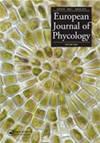盐度诱导河口褐藻脂类和脂肪酸的独特变化
IF 1.7
4区 生物学
Q2 MARINE & FRESHWATER BIOLOGY
引用次数: 2
摘要
盐度对微藻脂质影响的研究主要集中在绿藻种类上,对光合次生内共生生物的认识有限。亲藻就是这种情况的一个例子,它代表了一个有趣的模型,可以促进人们对微藻对盐度反应的高度系统发育变异性的认识。在盐度的影响下,河口Pavlovophyceae Diacronema vlkianum发生了特殊的脂类和脂肪酸变化。与脂类谱相比,脂肪酸谱的盐度变异性更高。在活跃生长的细胞中,甘油三酯随盐度降低,只有当盐度升高到50,细胞停止生长时才升高。高盐度引起了硫脂的轻微下降,磷脂酰甘油增加了4倍,这表明这种磷脂在耐盐性中起着关键作用。相反,甜菜碱脂质二酰基甘油羟甲基-N,N,N-三甲基-β-丙氨酸在高盐度下特异性降低。随盐度降低最多的脂肪酸为14:0、16:1n-7、20:4n-6、20:5n-3和22:6n-3,高盐度诱导的脂肪酸为16:1n-9、17:1、18:2n-6和18:3n-3。尽管脂肪酸含量发生变化,但不饱和指数不随盐度变化而变化,但在盐度为50时,由于20-C多不饱和脂肪酸含量降低,营养价值下降。这种脂质随盐度变化的模式在任何其他微藻中都没有描述过。虽然D. vlkium在很宽的盐度范围内生长,但在低盐度条件下更有利于营养和功能脂质的生产。本文章由计算机程序翻译,如有差异,请以英文原文为准。
Salinity induces unique changes in lipid classes and fatty acids of the estuarine haptophyte Diacronema vlkianum
Abstract Studies on the influence of salinity on microalgal lipids have focused mainly on chlorophyte species and knowledge about photosynthetic secondary endosymbionts is limited. Haptophytes exemplify this situation and represent an interesting model to advance knowledge about the high phylogenetic variability of microalgae in their response to salinity. The estuarine Pavlovophyceae Diacronema vlkianum underwent particular lipid class and fatty acid changes under the effect of salinity. Variability due to salinity was higher in the fatty acid profile compared with that of the lipid class profile. Triacylglycerols decreased with salinity in actively growing cells and increased only when salinity rose to 50 and cell growth ceased. Hypersalinity caused a slight, although significant, sulpholipid decrease and a 4-fold increase in phosphatidylglycerol, suggesting a key role for this phospholipid in salt tolerance. Conversely, the betaine lipid diacylglycerol hydroxymethyl-N,N,N-trimethyl-β-alanine was specifically decreased with high salinity. The fatty acids that decreased the most with salinity were 14:0, 16:1n-7, 20:4n-6, 20:5n-3 and 22:6n-3, while higher levels of 16:1n-9, 17:1, 18:2n-6 and 18:3n-3 were induced by high salinity. Despite fatty acid changes, the unsaturation index did not vary with salinity, but nutritional value of D. vlkianum decreased at a salinity of 50 due to a lower presence of 20-C polyunsaturated fatty acids. This pattern of lipid variation in D. vlkianum with salinity has not been described in any other microalgae. Although D. vlkianum grows within a wide salinity range, production of nutritional and functional lipids is more favourable at low salinity values.
求助全文
通过发布文献求助,成功后即可免费获取论文全文。
去求助
来源期刊

European Journal of Phycology
生物-海洋与淡水生物学
CiteScore
4.80
自引率
4.20%
发文量
37
审稿时长
>12 weeks
期刊介绍:
The European Journal of Phycology is an important focus for the activities of algal researchers all over the world. The Editors-in-Chief are assisted by an international team of Associate Editors who are experts in the following fields: macroalgal ecology, microalgal ecology, physiology and biochemistry, cell biology, molecular biology, macroalgal and microalgal systematics, applied phycology and biotechnology. The European Journal of Phycology publishes papers on all aspects of algae, including cyanobacteria. Articles may be in the form of primary research papers and reviews of topical subjects.
The journal publishes high quality research and is well cited, with a consistently good Impact Factor.
 求助内容:
求助内容: 应助结果提醒方式:
应助结果提醒方式:


